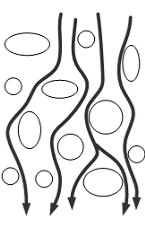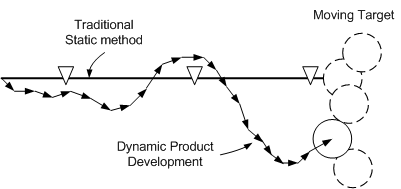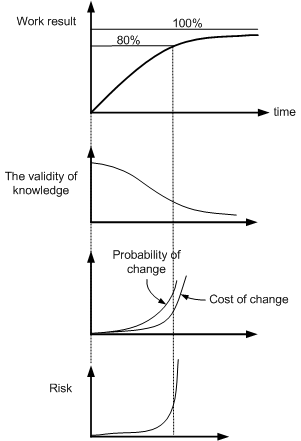Concentrate on the main problem
Identify the main problem, the big hindrance and attack it. When the main problem has been solved it is often easy to solve the lesser problems.
If the main problem cannot be solved then effort should not be wasted on the lesser problems, but terminate or redirect the project.
Like flowing water
This is a metaphor as well as a principle. The principle is to pass by lesser problems like water flows around smaller obstacles, without solving them just yet, or setting them aside and solving them separately from the main work, perhaps by aid of a special task force. The important characteristic is the flexibility of flowing water and its momentum.
If the obstacle is massive, water accumulates and eventually finds a weak point and breaks through. In the same way larger, perhaps critical problems are attacked and resolutely solved with the combined force of team members.
Switch between tasks
Your creative capability benefits from switching between different problems or work-tasks. Switch not only between design problems but also between design, prototype building, testing, talking to users, budgeting, sales, and back to design.
How many problems can you handle simultaneously, or rather consecutively in a repeated iterative way? This depends on experience, if you are tired, how you handle stress, etc, but surely somewhere between two and ten.
Tempo, initiative and money is lost if people spend their time waiting. If you for some reason can't continue with what's at hand, then shift over to something else until you're able to go back and continue with the first work-task.
However try always to work with what is the most important at the time.
The 80/20 rule
Initially the work result grows almost linearly with time. As we get closer to work finished, efficiency diminish, there is a knee on the curve and we now asymptotically move towards 100% finished.
One should stop working at the knee, approximately at 80% of work finished, of the following reasons.
The knowledge we start with is less valid the longer we keep on without replenishing with new knowledge (verify results, coalesce with the rest of the team, etc).
Therefore the probability, or risk that we will have go back and redo earlier work increase progressively the further we go.
The cost of changing design increase the longer we continue.
Risk = probability of change * cost of change. The risk increases very steeply beyond the knee of the curve.
It is very good practice to stop at roughly 80% finished and then shift to other tasks and in this way verify what one has produced and replenish ones knowledge.
A break is also good for one's creativity. During the break we get new impressions while at the same time the preconscious mind works with the problem.


Continuously develop the product concept and goals as you during work, gain more and more knowledge of the product and its user
This is adaptation to changing circumstances, which results in better products more in tune with user requirements.
Simultaneously gather facts - analyze - create solutions - test
The analysis and creation of solutions will yield new questions, which will lead to new inquiries, which will influence analysis and solutions, etc. Therefore they must all be done simultaneously for maximum efficiency.
Make many small, and few large, decisions
There is no need to follow a special order when solving problems, except that one should always start at the abstract level and then work downwards to the concrete level.
Like flowing water, our modus operandi should be dexterous, swift, and opportunistic. This flexible taking-advantage-of-opportunities is only possible if team members are fully informed and aware of the overall goal, objectives, and deliverables of the project. The project leader must also allow and encourage initiatives from team members.









